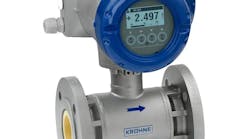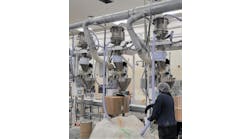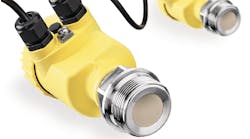Alternative Fuels Pose Flow-Metering Challenges
The physical properties of hydrogen differ highly from other gases. Plant operators are therefore faced with major challenges due to the necessary adaptations that need to be made. To help us understand the challenges and options available, Chemical Processing spoke with Frank Flow, head of analyzer products and chemical industry at Flexim Americas Corporation.
Q: Let’s set the stage in terms of alternative fuels. Can you give me an overview of what it means for your area of expertise?
A: Whether hydrogen, ammonia or biodiesel, chemical facilities and the market in general are using alternative fuels. It’s a little bit different from mass flow applications that we saw in the past, so we have to address how to measure those fuels.
Q: What challenges are there with Hydrogen (H2) gas measurement?
A: From the non-invasive ultrasonic standpoint, we've been measuring gases for a long time, and we've done a lot of flow measurement with pure hydrogen. Because it is a lighter molecule and because we're on the outside of the pipe — and the standard pipe that we're seeing is usually carbon steel or stainless — we need more pressure on those applications for that gas to be compressed to make the measurement.
If we're doing an existing application where somebody's moving to hydrogen, we have to ensure that we have enough pressure on that application to make a measurement.
We know where our limitations are. We know what some possible solutions are for it, so we are prepared from that standpoint. As people use hydrogen blends, they're using the available hydrogen, which is great because this is a clean, pure-burning fuel. It makes sense for them to use it from a regulatory and financial perspective. As you start dosing in hydrogen to a natural gas stream, there are several things that happen. The molecular weight of the gas changes, and this changes the compressibility factor of the gas. So now you have a dynamic change in the calculated mass flow, and it changes the BTU value or the energy content of what's flowing through that gas.
So as that mass for the molecular weight changes, that can be accounted for by using sound speed measurement along with pressure and temperature. If we can identify that the properties are changing and we can correlate this back to a percent hydrogen that's changing, we can dynamically correct for compressibility and for the BTU value just by using the inherent values that come out of the ultrasonic meter. So not only are you getting a volumetric flow, but you’re also getting a mass flow that's able to adjust for the properties of that gas. And the biggest factors that are going to impact our users are things like compressibility and energy content.
Currently, a customer must use several different devices to do that. In addition to a flow meter, the customer needs an analyzer for the gases. This information is calculated in an external controller along with the flow to provide mass flow and energy value. This information is required for managing combustion.
Q: What issues and limitations are there when using clamp-on ultrasonics?
A: On steel pipes, I would say the bottom of the pressure threshold right now with clamp-on-transit-time is 10 bar, 150 psi, and that's really kind of stretching. Ideally, you would be at 20 bar, 300-ish psi. Having that much pressure ensures robust signal strength and diagnostics. The great thing about transit time is that you're not really going to find a limitation on the velocity in most cases. So, you can have extremely high velocities down to low velocities because hydrogen application will require a larger turndown to meet the same energy requirements. If you've got a smaller pipe with a thicker wall, you're going to need more pressure, and you tend to see more pressure on those applications, but it's one of those limitations to be aware of with clamp-on. Depending on the pipe size and the velocities, you must be prepared to use different waveforms or frequencies.
There are going to be some limitations usually impacted by the pressure since it is a low-weight, small molecule — it's hydrogen, it's atomic number 1. So, when we get to other solutions that we're doing noninvasively, we're starting to use plastics or other pipe materials that allow us to get down to lower pressures. The lowest pressure that we've tested is about one bar, and that would be using a plastic pipe. The issue with ultrasonic is this impedance relationship, and that's where the steel requires more pressure. That's why we can work noninvasively on lower-pressure gases, by using different pipe materials.
Q: How are customers dealing with traditional hydrogen blending applications, and what new methods are being employed with ultrasonics?
A: Customers are taking some type of gas analyzer and calculating the properties using their DCS or a flow computer. Many people are using differential pressure technology. It's been around for a long time; it's understood. So that technology's out there. Newer customers or newer plants might use Coriolis technology, but that must be installed when the process is shut down. These technologies create a pressure drop, and there are going to be some limitations on the velocities and the pressure. Coriolis needs some pressure as well to make that measurement.
Q: Ammonia as an energy carrier is starting to take shape. What experience and problems with ammonia flow can clamp-on meters offer?
A: We're seeing ammonia more from the producer side. So, I haven't measured ammonia in an application where I knew that it was being used for combustion. However, I've measured ammonia when it's been used for other processes, whether it's at a chemical plant that's producing it or somebody that's using it for power generation to control emissions. So, from that standpoint, we've got a fair amount of experience measuring ammonia both in a gas or a liquid state. On the liquid side, it tends to be colder and more pressurized, and that's no problem for us being outside the pipe. If the transducers are insulated, you keep a moisture barrier and the ultrasonics work really well on ammonia. It's a straightforward measurement.
You want to be quick about how you do the installation because it does want to build up ice, especially in the south, because there's enough moisture in the air that it'll create ice on the surface of that pipe quickly. Obviously, it's a toxic gas, so you want to limit your leak points; it's a no-brainer from the standpoint of not creating a leak point.
When we move to the gas side, it's easier because it's a denser fluid. For steel pipes, we don't need as much pressure on that; typically, around 100 PSI is fine. Unless we get into a smaller pipe with a thicker wall, that's going to be your exception there. The one thing to watch out for is if you have a two-phase, so if the liquid's turning into a gas or vice versa, this would be a problem for ultrasonic technology and a problem for most flow technology at a certain point.
Q: Bio Diesel is another developing green energy. What are you seeing that’s unique to this process, and are ultrasonic meters a viable means of metering for some of these processes?
A: Biodiesels are taking waste products or plant-based oils, and they're producing a diesel product with it. Throughout that entire process, ultrasonics work quite well, even though there are changing properties and constituents. If the fluid properties are changing enough, the mass balance aspect gets challenged with ultrasonic technology, but you still get volumetric flow and an indication of what's going on in the pipe. The temperature in these applications is usually higher, so if you've got a means of making a measurement noninvasively, it makes sense because now you're not exposing your maintenance workers to a possible safety issue.
The other side of that is we're seeing corn oil, soybean oil and other things like that that are used for diesel. These are friendly for ultrasonic technologies, and most of the processes work quite well for clamp-on.
Q: Is there anything you’d like to add?
A: The basics of what we're still seeing, even in some of these new processes, are our traditional utility measurements, which the clamp-on ultrasonic technologies are proven. On the emerging side are things like CO2 to diesel or e-diesel, I think that's earth-changing; people are capturing their CO2 and they're repurposing it back into a fuel.
And that would be the one thing I would touch on for ultrasonics too. Our gaseous CO2 at this point is still not something that we can do with a clamp-on transit time technology. There are some in-situ ultrasonic technologies that look like they can handle that measurement. Clamp-on can work reliably on supercritical gases – where the pressure and temperature are above the critical point – and on liquid-dense CO2. Supercritical fluids have some of the same issues with Equation of State calculations mentioned in the above hydrogen blending. Again, sound speed becomes a beneficial auxiliary measure that can provide value in calculating mass flow.
For more information, visit: www.flexim.com/en/hydrogen-economy and visit here to learn more about hydrogen grading and blending.





